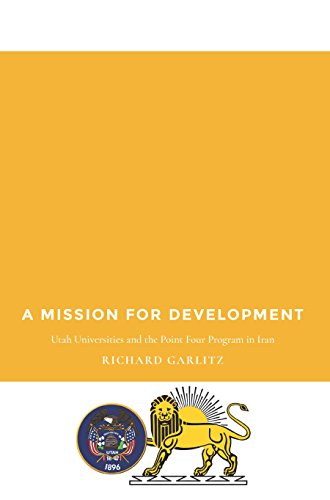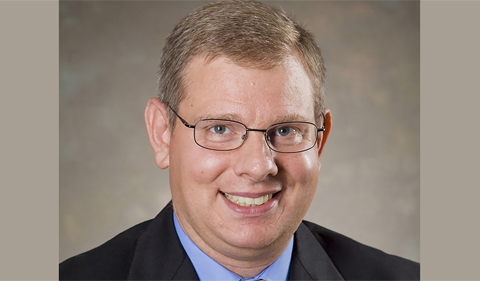Upon leaving Athens, Dr. Ricky Garlitz joined the History and Philosophy Department at the University of Tennessee at Martin, where he is now an associate professor. Garlitz specializes in U.S. diplomatic history while also offering courses on the history of the Middle East.
Garlitz earned a Ph.D. in History under the direction of Dr. Chester Pach and a Contemporary History Certificate from Ohio University in 2008 following a B.A. from Purdue and an M.A. from Ball State University.
He recently published his first monograph, A Mission for Development: Utah Universities and the Point Four Program in Iran, with Utah State University Press and is the co-editor of Teaching America to the World and the World to America: Education and Foreign Relations since 1870 (Macmillan, 2012).
The Contemporary History Institute recently contacted Garlitz to discuss his career and the impact that CHI has had on it.
As a diplomatic historian, what and who has shaped your career as well as your intellectual development? Are there scholars or specific works that have influenced you more than others?
I’ve always been interested in both U.S. history and the wider world, so diplomatic history seemed like the natural way to combine those interests. Developments from the Sept. 11 attacks to the looming conflicts in Afghanistan and Iraq piqued my interest in the Middle East when I began my Ph.D. in 2002. Of course, I also hoped that expertise in the region’s diplomacy would enhance my employment prospects.
Dr. Pach proved a diligent and punctual advisor who pushed me to refine my topic and write more clearly. Dr. Sholeh Quinn, who is now at the University of California-Merced, introduced me to Middle East history and taught me the basics of Iranian and Turkish modernization. Outside of Ohio University, I owe a debt of gratitude to George Herring, whose From Colony to Superpower has been my main diplomatic history textbook for ten years, and Walter McDougall, whose Promised Land, Crusader State provides a good framework for organizing the main historical themes in U.S. diplomacy. I’ve also learned a great deal about U.S.-Iranian relations from scholars such as Ervand Abrahamian and Mark Gasiorowski.
You teach a mixture of courses on U.S. and Middle East history. What is the relationship between your own research and teaching? What direction is your research headed in?
My research has challenged me to emphasize the role of international development in modern diplomacy. It has also forced me to wrestle with the complicated relationship between the socio-economic and the political sides of foreign aid. My work has also deepened my understanding of authoritarian development in the 20th century Middle East and required me to gain a more nuanced understanding of both Iranian political history and the evolution of the U.S.-Iranian alliance.
I’m still interested in connections between American universities and international affairs, so I’m planning a follow-up book that will explore the broader contributions that universities have made to international development since the 1940s, both inside and outside government programs. I also want to write an article that traces how early Cold War foreign technical assistance programs such as Point Four and its successor, the Agency for International Development, contributed to the internationalization of American higher education after World War II.
Your recent book, A Mission for Development, is based on your dissertation. What was the road like from dissertation to manuscript? Has your perspective and thinking evolved in any way during the intervening time?
It was a long road, 10 years. Like many junior faculty members, my life revolved around designing and refining new classes during my first few years at UT-Martin. I was also uncertain about how to convert my dissertation into publications. I spent the summers of 2009 and 2010 pursuing a book-length study of the Point Four Program, but I set that aside in 2011 when I agreed to co-edit a collection of essays on the connections between international education and foreign relations. That project consumed most of the next two years, but it also allowed me to revisit some of the Iran projects. Then, in 2013, a colleague introduced me to an editor at Utah State University Press who was interested in a book about the Utah universities’ contributions to Point Four work in Iran. I was better established in my teaching career by that point, but I also had an infant daughter. It wasn’t until the summer of 2014 that I turned my full attention to the book. I made two additional research trips to Utah, and UT-Martin awarded me a semester of leave in the fall of 2015 to complete the manuscript. Peer review, revisions, and production all went smoothly in 2016 and 2017.
set that aside in 2011 when I agreed to co-edit a collection of essays on the connections between international education and foreign relations. That project consumed most of the next two years, but it also allowed me to revisit some of the Iran projects. Then, in 2013, a colleague introduced me to an editor at Utah State University Press who was interested in a book about the Utah universities’ contributions to Point Four work in Iran. I was better established in my teaching career by that point, but I also had an infant daughter. It wasn’t until the summer of 2014 that I turned my full attention to the book. I made two additional research trips to Utah, and UT-Martin awarded me a semester of leave in the fall of 2015 to complete the manuscript. Peer review, revisions, and production all went smoothly in 2016 and 2017.
The long interval was frustrating, but it also helped clarify my thinking. My dissertation did a reasonable job sketching the limitations of American technical assistance in countries such as Iran, but my book draws stronger connections between development aid and the broader objectives of U.S. foreign policy. Most American technical advisors enthusiastically supported the overarching U.S. narrative about the Cold War. That narrative no doubt motivated and sustained them, but it also sometimes led them to misunderstand what was actually happening in the countries they served. Iran is very good example of that.
Looking back, did Contemporary History Institute courses and events, as well as the environment created by CHI itself, prepare you for your academic career? Do you have any advice for current students?
The most important thing is that I met my wife, Renee LaFleur (Ph.D., 2011), through CHI and the history graduate program.
In terms of academic preparation, the Thursday afternoon CHI talks exposed me to many interesting dimensions of U.S. foreign policy and the contemporary Middle East. The Baker Peace Conference brought a remarkable collection of academic experts and senior practitioners to campus during my time including Akira Iriye, Zbigniew Brzezinski, Dennis Ross, and Strobe Talbott. So, my first advice is take those events seriously. You’ll meet accomplished experts in various fields of contemporary history.
I also benefited from the fact CHI brings together graduate students with similar interests. I learned a great deal from the students who were ahead of me in the program.
Take advantage of the CHI practicum. I spent the summer of 2005 in Istanbul studying Turkish and doing preliminary research on my dissertation. Such an experience would not have been possible without the generous support of the history department and the Contemporary History Institute.
Two last thoughts: first, design your dissertation with an eye toward converting it into a book or articles. I did not pay enough attention to that, and that is one reason it took me ten years to produce my first monograph. Second, maximize your teaching assignments if you’re interested in a career in college teaching. In today’s job market you have to have teaching experience.




















Comments